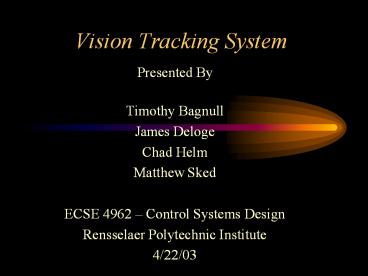Vision Tracking System - PowerPoint PPT Presentation
Title:
Vision Tracking System
Description:
Vision Tracking System Presented By Timothy Bagnull James Deloge Chad Helm Matthew Sked ECSE 4962 Control Systems Design Rensselaer Polytechnic Institute – PowerPoint PPT presentation
Number of Views:205
Avg rating:3.0/5.0
Title: Vision Tracking System
1
Vision Tracking System
- Presented By
- Timothy Bagnull
- James Deloge
- Chad Helm
- Matthew Sked
- ECSE 4962 Control Systems Design
- Rensselaer Polytechnic Institute
- 4/22/03
2
Overview
- Objective and Specifications
- System Design
- Testing and Verification
- Problems Encountered
- System Demonstration
- Conclusions
3
System CAD Model
4
Objective and Specifications
- Track a moving point with a camera and pan-tilt
system. - Controller Specifications
- Maximum target speed 1 ft/s
- Settling time 0.1 s
- Overshoot 2
- Vision Specifications
- Initialize system using an edge detection
algorithm - Track target using a Kalman Filter
5
System Design Controller
- Linear Controller
- Effects of Coulomb Friction
- Real Time System Response
- Motor Saturation
6
System Design ControllerLinear Controller - Pan
7
System Design Controller Linear Controller -
Tilt
8
Effects of Coulomb Friction
9
Effects of Coulomb Friction
10
System Design ControllerReal Time System
Response - Pan
11
System Design ControllerReal Time System
Response - Tilt
12
System Design ControllerMotor Saturation - Pan
13
System Design ControllerMotor Saturation - Tilt
14
System Design Vision
- Implemented using C
- 4 levels of communication
- Camera Frame Grabber Computer - ARCS
- Find the target Roberts Edge Detector
- Track the target Incremental Step Function
- Future Modification Kalman Filter, Pattern
Recognition
15
System Design Vision
- Roberts Edge Detector
- Calculates the first order image gradient
magnitude - Through a threshold function we determine which
pixels are line pixels and which are not - By assuming an ideal environment we can calculate
the center of the point by taking the mean of our
line pixels
16
System Design Vision
Normal Lighting Conditions
Original Screen Grab Edge Detection
Output
17
System Design Vision
Poor Lighting Conditions
Original Screen Grab Edge Detection
Output
18
System Design Vision
Focus Conditions
Original Screen Grab Edge Detection
Output
19
System DesignVision
- Incremental Step Function
- Determines target position in coordinate frame
- Steps towards target using increment function
(0,0)
(640,0)
-,-
,-
(320,240)
,
-,
(480,0)
(640,480)
20
Testing and Verification
- Controller
- Trajectory program
- Line,Circle, Jog Functions
- Vision
- Edge Detection
- Incremental Step Function
- System
21
Problems Encountered
- Real time system controller tuning vs. simulated
controller tuning - Coordinate transformations between vision and
ARCS systems - Learning programming interfaces between
mechanical and visual systems
22
Final System Performance
- Final Performance
- Maximum tracking speed 0.5 ft/s
- Settling time 1 s
- Overshoot 50
- Initial Specifications
- Maximum target speed 1 ft/s
- Settling time 0.1 s
- Overshoot 2
23
Open Loop ResponsePan Torque at 0.1 Nm
24
Open Loop ResponseTilt Torque at 0.09Nm
25
Conclusion
- We successfully implemented a vision system with
a mechanical pan/tilt - Future work can be done to make this system much
more robust - Overall we have shown that vision can be a used
as an effective sensor in controls
26
Demonstration
- Independent joint test
- Track horizontally moving target
- Track vertically moving target
- System test
- Random Motion
- Tracking performance test
27
(No Transcript)
28
Questions?

